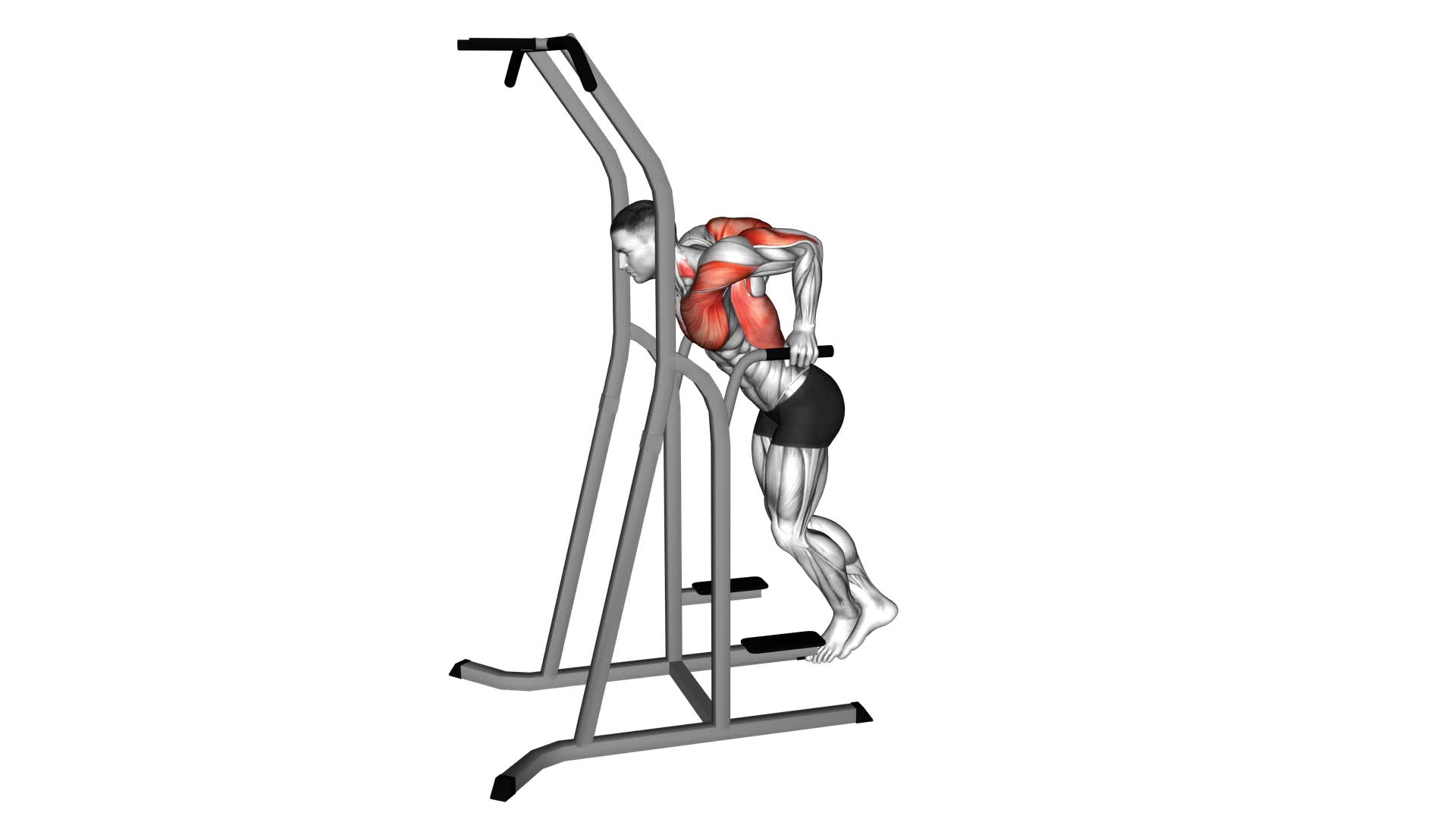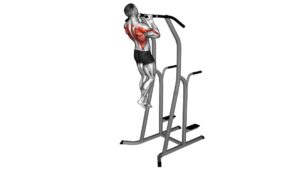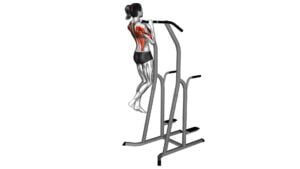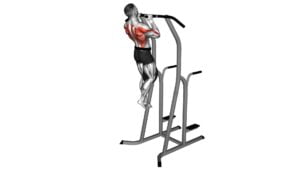Chest Dip (On Dip Pull-Up Cage) – Video Exercise Guide & Tips

Looking to target your chest muscles? The chest dip exercise is an effective way to do just that.
Watch This Exercise Video
In this video exercise guide, we'll show you the proper form and technique for performing chest dips on a dip pull-up cage.
Whether you're a beginner or advanced, we've got modifications for everyone. Avoid common mistakes and learn tips for increasing intensity and progression.
Get ready to take your chest workout to the next level.
Key Takeaways
- Chest dip exercise targets multiple muscle groups in the upper body.
- Proper form and technique include leaning slightly forward, lowering body until upper arms are parallel to the ground, and tightening abdominal muscles for stability.
- Equipment needed for chest dip includes a dip pull-up cage or dip station, parallel bars, or sturdy chairs.
- Safety precautions and modifications include warming up muscles, starting with lower intensity, listening to your body, and using resistance bands or benches for assistance.
Benefits of Chest Dip Exercise
To maximize your workout routine, it's crucial that you understand the benefits of incorporating the chest dip exercise.
Chest dips are a highly effective exercise that target multiple muscle groups in your upper body.
One of the main benefits of chest dip variations is that they work your chest muscles, specifically the pectoralis major and minor. These muscles are responsible for pushing movements and developing a strong and defined chest.
Additionally, chest dips also engage your triceps, which are located on the back of your upper arms. Strengthening your triceps not only improves your overall arm strength, but also enhances your performance in other exercises such as push-ups and bench presses.
Another muscle group targeted during chest dips is your deltoids, which are the muscles on the sides of your shoulders. Strengthening your deltoids can improve your shoulder stability and overall upper body strength.
Proper Form and Technique
Maintain proper form and technique while performing chest dips on the dip pull-up cage for maximum effectiveness. Here are some tips to help you achieve optimal results:
- Keep your body upright: Lean slightly forward with your chest out and shoulders back. This posture engages your chest muscles and prevents excessive strain on your shoulders.
- Control your movement: Lower your body until your upper arms are parallel to the ground. Avoid swinging or bouncing as this can reduce muscle activation and increase the risk of injury.
- Engage your core: Tighten your abdominal muscles throughout the exercise to stabilize your body and maintain proper alignment. This helps to prevent unnecessary stress on your lower back.
- Experiment with different variations: Try incorporating different chest dip variations into your routine to target different areas of your chest and add variety to your workouts. Some popular variations include wide grip dips, narrow grip dips, and weighted dips.
By following these tips and maintaining proper form and technique, you can ensure that you're getting the most out of your chest dip exercises. Remember to listen to your body and adjust the intensity and difficulty level as needed.
Happy dipping!
Equipment Needed for Chest Dip
To perform chest dips effectively, you'll need some essential equipment.
The primary equipment needed for chest dips is a dip cage or dip station, which provides a stable structure for you to perform the exercise. However, if you don't have access to a dip cage, there are alternative options, such as parallel bars or even sturdy chairs.
Regardless of the equipment you use, it's crucial to prioritize safety and take necessary precautions. This includes maintaining proper form and using appropriate padding or grips to prevent injuries.
Essential Equipment for Chest Dips
You will need a dip pull-up cage for performing chest dips. This essential equipment provides the necessary support and stability for executing the exercise effectively.
Here are four items that are important for performing chest dips:
- Dip Bars: These are the main components of the dip pull-up cage that allow you to grip and support your body weight during the exercise.
- Adjustable Height: Having an adjustable height feature enables you to customize the difficulty level and target different muscle groups.
- Sturdy Construction: It's crucial to have a dip pull-up cage that's built with durable materials to ensure safety and stability during your workouts.
- Comfortable Padding: Look for equipment that provides adequate padding on the dip bars to minimize discomfort and prevent any potential injuries.
Alternatives to Dip Cages
If you don't have access to a dip pull-up cage, there are alternative equipment options you can use for performing chest dips. Dip station alternatives can include parallel bars, parallettes, or even two sturdy chairs placed parallel to each other. These alternatives provide a stable surface for you to perform the exercise and target your chest muscles effectively.
Additionally, you can also perform bodyweight chest exercises such as push-ups, decline push-ups, or bench dips to work your chest muscles without any equipment. These exercises can be modified to increase or decrease the difficulty level based on your fitness level.
Now that you know the alternatives to dip cages, let's move on to discussing some safety precautions for dips.
Safety Precautions for Dips
Ensure the equipment's stability by checking its sturdiness and the tightness of its screws before performing chest dips. Safety precautions are crucial to prevent common injuries and ensure a productive workout. Here are some important steps to follow:
- Warm up: Before starting your chest dips, warm up your muscles with light cardio exercises like jogging or jumping jacks. This helps increase blood flow and prepares your body for the workout.
- Use proper form: Maintain proper form throughout the exercise to avoid strain on your shoulders, elbows, and wrists. Keep your core engaged, shoulders down, and elbows tucked in.
- Start with lower intensity: If you're new to chest dips, start with assisted dips or use a resistance band to reduce the load on your muscles. Gradually increase the intensity as you gain strength and confidence.
- Listen to your body: Pay attention to any discomfort or pain during the exercise. If you experience any unusual sensations, stop immediately and consult a professional.
By following these safety precautions, you can minimize the risk of injury and make the most out of your chest dip workout.
Now, let's move on to discussing modifications for beginners and advanced individuals.
Modifications for Beginners and Advanced
To modify the chest dip exercise for beginners and advanced individuals, incorporate variations that suit your fitness level.
For beginners, it's important to start with easier modifications to build strength and proper form. One modification is to use a resistance band for assistance. Loop the band around the dip bars and place your knees or feet in the band, depending on your strength level. This will help reduce the amount of body weight you need to lift and make it easier to perform the exercise.
Another modification is to perform the chest dip on a bench or step instead of using the dip bars. This will decrease the range of motion and make the exercise less challenging.
For advanced individuals, there are several ways to increase the difficulty of the chest dip. One modification is to add additional weight by using a weight belt or holding a dumbbell between your feet. This will increase the resistance and make the exercise more challenging.
Another modification is to perform the chest dip on gymnastic rings instead of using the dip bars. This will require more stability and core strength.
Additionally, you can slow down the tempo of the exercise by performing the dips in a controlled manner, focusing on the eccentric (lowering) phase. This will increase the time under tension and intensify the workout.
Remember to always listen to your body and progress gradually to avoid injury.
Common Mistakes to Avoid
When performing chest dips on a dip pull-up cage, it's important to be aware of common mistakes to avoid. Incorrect form can lead to potential dangers, such as strain or injury to the shoulders, elbows, or wrists.
Additionally, improper usage of the equipment, such as not adjusting the bars to the correct height, can also impact the effectiveness and safety of the exercise.
Incorrect Form Dangers
Avoiding proper form during chest dips can lead to potential injuries and decreased effectiveness of the exercise. To ensure you're performing chest dips correctly and minimizing the risks of incorrect form, be aware of the following dangers:
- Shoulder strain: Leaning too far forward or allowing your shoulders to roll forward can put excessive stress on your shoulder joints.
- Lower back pain: Arching your back or swinging your legs can strain your lower back, leading to discomfort and potential injury.
- Elbow strain: If you allow your elbows to flare out too much during the exercise, you may experience pain and strain in your elbows.
- Wrist injuries: Putting too much pressure on your wrists by gripping the bars incorrectly or allowing them to bend can result in wrist injuries.
Improper Equipment Usage
Make sure you avoid these common mistakes when using the dip pull-up cage for chest dips. Improper equipment usage can lead to injuries and hinder your progress.
One mistake to avoid is using the dip pull-up cage for chest dips when there are alternative dip machines available. Dip machines are specifically designed for this exercise and provide better stability and support.
Another mistake is using the dip pull-up cage with improper form. This can put excessive strain on your shoulders, elbows, and wrists, increasing the risk of injury. Always maintain proper form by keeping your body straight, elbows tucked in, and lowering yourself to a comfortable depth.
Tips for Increasing Intensity and Progression
To increase the intensity and progression of your chest dips on the dip pull-up cage, incorporate more repetitions into each set. This will challenge your muscles and help you build strength and endurance over time.
However, simply increasing repetitions isn't the only way to make your chest dips more challenging. Here are some tips to help you take your chest dips to the next level:
- Use additional weight: By adding weight to your body, either through a weight belt or by holding a dumbbell between your legs, you can increase the difficulty of the exercise. Start with a weight that allows you to perform 8-12 reps with proper form and gradually increase the weight as you get stronger.
- Try advanced variations: Once you have mastered the basic chest dip, you can incorporate advanced variations to further challenge your muscles. Some examples include weighted chest dips, explosive chest dips, or one-arm chest dips.
- Slow down the tempo: Instead of performing your chest dips at a regular pace, try slowing down the movement. This will increase the time under tension and make the exercise more challenging.
- Decrease rest time: By reducing the rest time between sets, you can increase the intensity of your workouts. This will help improve your cardiovascular fitness and promote muscle growth.
Frequently Asked Questions
How Many Repetitions and Sets Should I Do for Chest Dips?
For chest dips, the number of repetitions and sets will depend on your fitness level and goals. However, it's generally recommended to start with 3 to 4 sets of 8 to 12 repetitions. This will help build strength and muscle endurance in your chest, shoulders, and triceps.
Chest dips are a great exercise that targets multiple muscles and can be modified with different variations to challenge your body and maximize the benefits of your workout.
Can Chest Dips Help With Building Muscle Mass?
Chest dips are an effective exercise for building muscle mass. They target your chest, shoulders, and triceps, helping to strengthen and define these areas. Compared to the bench press, chest dips activate more muscles and provide a greater range of motion.
This can lead to better muscle development and overall strength gains. Incorporating chest dips into your workout routine can be a great way to enhance your upper body strength and achieve your muscle-building goals.
Is It Safe to Do Chest Dips if I Have Shoulder or Elbow Injuries?
Chest dips can be a suitable exercise for beginners, but if you have shoulder or elbow injuries, it may not be safe. It's important to prioritize your safety and consult with a healthcare professional before attempting chest dips.
Common mistakes to avoid while performing chest dips include using improper form, going too deep, and not engaging your core. Remember to start slowly, use proper technique, and listen to your body to prevent further injury.
Can Chest Dips Help With Improving My Bench Press?
Chest dips, a variation of the dip exercise, can indeed help improve your bench press. By targeting the chest muscles, triceps, and shoulders, chest dips can increase upper body strength and stability. As you build strength in these muscles, your bench press performance may improve.
The benefits of chest dips extend beyond the bench press, as they also help develop overall upper body strength and muscular endurance. Incorporating chest dips into your workout routine can be a valuable addition.
Are There Any Alternatives to Chest Dips That Target the Same Muscle Groups?
There are several alternatives to chest dips that target the same muscle groups.
You can try push-ups, bench press, or dumbbell flyes to work your chest muscles. These exercises can also help improve your upper body strength and provide similar benefits as chest dips.
However, it's important to note that chest dips offer a unique range of motion and activation of muscles that may not be fully replicated by other exercises.
Conclusion
In conclusion, the chest dip exercise is a highly effective workout for targeting the chest muscles.
It can be performed using a dip pull-up cage and requires proper form and technique to maximize its benefits.
Beginners and advanced individuals can modify the exercise to suit their fitness level.
However, it's important to avoid common mistakes and follow tips for increasing intensity and progression.
Incorporating chest dips into your workout routine can help you achieve a stronger and more defined chest.

Author
Years ago, the spark of my life’s passion ignited in my mind the moment I stepped into the local gym for the first time. The inaugural bead of perspiration, the initial endeavor, the very first surge of endorphins, and a sense of pride that washed over me post-workout marked the beginning of my deep-seated interest in strength sports, fitness, and sports nutrition. This very curiosity blossomed rapidly into a profound fascination, propelling me to earn a Master’s degree in Physical Education from the Academy of Physical Education in Krakow, followed by a Sports Manager diploma from the Jagiellonian University. My journey of growth led me to gain more specialized qualifications, such as being a certified personal trainer with a focus on sports dietetics, a lifeguard, and an instructor for wellness and corrective gymnastics. Theoretical knowledge paired seamlessly with practical experience, reinforcing my belief that the transformation of individuals under my guidance was also a reflection of my personal growth. This belief holds true even today. Each day, I strive to push the boundaries and explore new realms. These realms gently elevate me to greater heights. The unique combination of passion for my field and the continuous quest for growth fuels my drive to break new ground.







